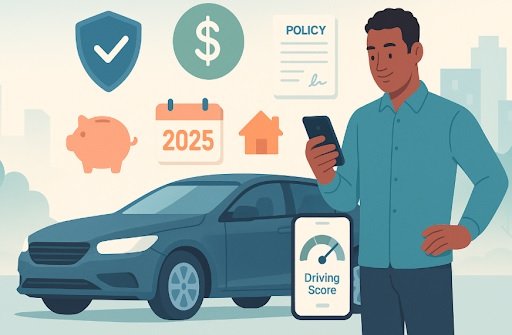Here’s the revised article with only two links total (one for each URL). I placed the second link roughly 500 words after the first.
If your renewal jumped this year, you’re not imagining it. Parts, labor, medical costs, and weather losses all pushed rates up across many states. The good news: you still have levers—practical, low-risk ones—to bring your premium back in line without leaving yourself exposed.
This guide is written for everyday drivers. Short sections, plain language, and clear trade-offs so you can decide quickly and confidently.
Why premiums changed—and what you can control
Insurers price risk using dozens of inputs. Some you can’t change (ZIP code, age), but many you can influence:
- Annual mileage and commute pattern (remote or off-peak helps).
- Driving behavior if you opt into telematics.
- Coverage design (liability limits, deductibles, extras).
- Vehicle (safety tech reduces crashes but can raise repair costs).
- Credit-based insurance score where permitted.
- Tickets and claims (most surcharges fade after 36 months).
Think in risk per dollar. The goal isn’t the absolute cheapest price; it’s the best protection you can comfortably afford.
For a quick primer on the market backdrop, scan 2025 insurance trends for drivers and homeowners.
Keep, adjust, or skip? A quick coverage map
High value per dollar (usually keep or raise):
- Bodily injury liability: Medical care and legal costs are expensive; many drivers do well with 100/300/100 or higher.
- UM/UIM (uninsured/underinsured motorist): Protects you when the other driver is under-insured.
- Medical Payments/PIP (where available): Pays regardless of fault and can fill health-insurance gaps.
Adjust thoughtfully:
- Collision and comprehensive deductibles: Moving from $500 → $1,000 can trim premiums if your emergency fund can handle the difference.
- Rental reimbursement: Keep if you’d struggle without a car; otherwise, optional.
- Roadside: Avoid duplication with your credit card or auto-club.
- Glass coverage: Great in hail/sand states; less essential elsewhere.
What actually lowers premiums? A realistic matrix
The table below shows illustrative ranges—actual impacts vary by state, carrier, and profile. Use it as a conversation starter when quoting.
| Lever You Can Pull | Typical Premium Impact* | Risk Trade-Off | When It Makes Sense |
|---|---|---|---|
| Enroll in telematics (safe-driver app/device) | −5% to −25% | Driving data is tracked | Mostly off-peak driving, smooth habits |
| Raise collision deductible ($500 → $1,000) | −6% to −12% | Higher out-of-pocket after a crash | Emergency fund can handle $1k |
| Raise comprehensive deductible ($500 → $1,000) | −3% to −8% | Higher cost for theft/hail/glass | Garage-kept, lower-risk area |
| Bundle auto + home/renters | −5% to −20% | Fewer à-la-carte options | You already carry home/renters |
| Switch to pay-in-full or EFT | −2% to −10% | Larger cash outlay up front | You can float it; avoid billing fees |
| Claim-free & defensive-driving course | −5% to −10% | Course time | Ticket/accident on record or teen driver |
| Remove duplicate roadside/rental | −1% to −4% | Lose convenience | Coverage already exists elsewhere |
*Estimated market ranges; your results will differ.
A 45-minute shopping plan that works
- Freeze your specs. Decide liability limits and deductibles before you start. Shopping with fixed specs lets you compare apples to apples.
- Pull 4–5 quotes. Include a national carrier, a regional/mutual, and a telematics-friendly option.
- Apply every discount. Multi-vehicle, good student, homeowner, defensive driving, anti-theft, paperless, EFT, and new-customer promos.
- Run a quick “what-if.” Price $500 vs. $1,000 deductibles, verify UM/UIM limits match liability, and test pay-in-full vs. monthly.
- Check service quality. Search recent claim reviews for your state; if you want guidance, involve an independent agent.
- Choose a 12-month term when available. It can stabilize price during volatile periods.
- Calendar a 5-month check-in. Mileage change? New discounts? Adjust mid-term if it lowers costs without weakening protection.
Telematics: strong savings, a few caveats
Pros
- Personalized pricing that rewards gentle driving and low mileage.
- Fast path to savings for remote workers or second cars.
- Often stacks with other discounts.
Cons
- Privacy: Apps may record hard braking, acceleration, phone distraction, night driving, and location.
- Score volatility: A handful of harsh events (e.g., a rushed airport run) can dent your result.
Tips to win the game
- Enroll after routine maintenance—fresh tires and brakes help smoothness.
- Use Do Not Disturb while driving to avoid phone-use dings.
- If your carrier allows a trial score before binding, test it first.
Monthly-friendly setups without surprises
You’ll see ads promising “start for $0 down.” Usually that means you begin by paying only the first month, not an extra deposit. Helpful if cash flow is tight, but verify:
- Installment fees and policy fees: Ask for the total cost over 6 or 12 months.
- Autopay/EFT discounts: These often-offset installment charges.
- Bundling with renters/home: One bill, larger discount, simpler paperwork.
To understand where product design is heading, including connected-car data and smarter auto-home bundles, read smarter coverage innovations for 2025.
Common money-saving myths (and better moves)
- “State minimums are fine.”
They rarely cover a serious crash. Price higher liability limits first; trim extras only if needed. - “I’ll drop collision on my financed car.”
Lenders require it. Instead, raise the deductible or ask about a mileage-based rate. - “Shopping mid-term hurts my credit.”
Quotes typically use soft pulls, and switching at renewal avoids cancellation fees. - “Every endorsement makes me safer.”
Focus on high-impact risks first: liability, UM/UIM, and rental coverage if you can’t be without a car.
If you’ve had a recent ticket or claim
- Ask about forgiveness. Some carriers forgive a first at-fault accident or minor violation.
- Take a defensive-driving course. Especially helpful for youthful drivers and sometimes required to reinstate discounts.
- Re-shop at key anniversaries. Surcharges can ease at 12, 24, and 36 months.
- Use telematics as a reset. A strong score can offset a blemish over time.
Quick pre-bind checklist
- Liability selected (aim for 100/300/100 or better)
- UM/UIM added at similar limits
- Deductibles match your emergency fund ($500 vs. $1,000)
- Telematics considered (privacy trade-off understood)
- All discounts applied (bundle, EFT, paperless, defensive course, anti-theft)
- Total term cost verified (fees, installments, surcharges)
- Renewal reminder set for 30–45 days before expiration
FAQs in 90 seconds
Will switching carriers erase loyalty discounts?
Yes, but many carriers offer new-customer pricing that can more than offset loyalty credits. Compare the full 6–12 month totals.
Is OEM parts coverage worth it?
If your car is newer—or leased—and you care about resale or lease return standards; OEM parts coverage can be a smart add-on.
What if I sometimes drive late at night?
One or two late trips won’t tank a telematics score. If your schedule is consistently late-night, weigh potential surcharges before enrolling.
Bottom line
You can’t control the weather or global parts inflation—but you can tune your policy to your life. Keep strong liability and UM/UIM, right-size deductibles, consider telematics, and bundle when it genuinely saves money. Then automate payments and revisit near renewal. That’s how to make auto insurance work for you in 2025.
About this guide
This article offers general, 2025-relevant guidance based on common insurer practices. Laws and product features vary by state and carrier. If your situation is complex (teen driver, rideshare, commercial use), speak with a licensed independent agent for tailored advice.



